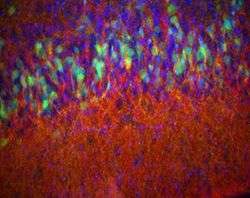Paleocortex
In anatomy of animals, the paleocortex, or paleopallium, is a region within the telencephalon in the brain which is older in an evolutionary sense (i.e. phylogenetically) than the archicortex (or archipallium) and the neocortex (or neopallium).
| Paleocortex | |
|---|---|
 Piriform cortex from a 14-day-old D2-eGFP (green) mouse stained for enkephalin (red) and DAPI (blue) to show nuclei. Epifluorescence. | |
| Details | |
| Part of | Cerebral cortex |
| Identifiers | |
| Latin | Paleocortex |
| NeuroNames | 2336 |
| NeuroLex ID | nlx_143559, birnlex_1097 |
| TA | A14.1.09.303 |
| TE | E5.14.3.4.3.1.34, E5.14.3.4.3.1.33 |
| FMA | 62430 |
| Anatomical terms of neuroanatomy | |
The paleocortex (or paleopallium) and the archicortex (or the archipallium) of the cerebral cortex together constitute the allocortex or the heterogenetic cortex. The distinction for what is called neocortex or isocortex, which comprises most of the human brain (about 90%), is made from the number of cellular layers that the structure comprises. Neocortical tissue comprises six distinct cell layers, not seen in paleocortical tissues either in adult or developing stage.
In humans the paleocortex is exemplified in the olfactory cortex.
Paleocortex is also defined as a type of cortical tissue that consists of three cortical laminae (layers of neuronal cell bodies).[1] In comparison, the neocortex has six layers and the archicortex has three or four layers.[2] Paleocortex, along with archicortex and periallocortex, is a type of allocortex.[3] Because the number of laminae that compose a type of cortical tissue seems to be directly proportional to both the information-processing capabilities of that tissue and its phylogenetic age, paleocortex is thought to be an intermediate between neocortex and archicortex in both aspects.[4]
Locations
Paleocortex is present in the parahippocampal gyrus,[4] olfactory bulb, accessory olfactory bulb, olfactory tubercle, piriform cortex, periamygdalar area,[3] anterior olfactory nucleus, anterior perforated substance, and prepyriform area.
Parts of the paleocortex
References
Parent, A. (1996). Carpenter's human neuroanatomy (9th ed.). Philadelphia: Williams &Wilkins.
- Purves, Dale; Augustine, George J; Fitzpatrick, David; Hall, William C; LaMantia, Anthony-Samuel; White, Leonard E (2011). Neuroscience (5th ed.). Sinauer Associates Inc. p. 666. ISBN 9780878936465.CS1 maint: uses authors parameter (link)
- Purves et al: Neuroscience 3rd Edition, 2004, page 617
- "Paleocortex". BrainInfo. University of Washington. Retrieved 5 May 2013.
- Purves, Dale; Augustine, George J; Fitzpatrick, David; Hall, William C; LaMantia, Anthony-Samuel; White, Leonard E (2011). Neuroscience (5th ed.). Sinauer Associates Inc. ISBN 9780878936465.CS1 maint: uses authors parameter (link)